Partnership2Gether unites women

JFO Israel Engagement and Outreach Director
From Nov. 13-16, the Federation hosted 15 women from Israel - some Jewish, some Arab Muslim - through a Partnership2 Gether program called Women Leading a Dialogue (WLD). Our guests brought with them songs, dancing, laughter, and a passion for coexistence.
The mission of the WLD program is to find mutual ground and to strengthen the bond between Arab and Jewish women from the Western Galilee in addition to exposing and involving our partnered communities to the complexity and diversity of the Western Galilee through this group. Each woman had a unique story, and a desire to create a world of shared cultures.
The very short two-and-a-half-day trip was packed full from morning to evening
with various types of activities. Some were community-building (teaching Friedel’s first and second graders games and songs in both Hebrew and Arabic), some were educational (a tour of “Portraits of Survival” led by Scott Littky), and some were just for fun (a tap dance class at the JCC).
A lunch and learn on Tuesday brought together JFO staff and our Israeli guests for meaningful conversations surrounding shared societies and what coexistence looks like (and lunch from Star Catering!). Staff involved greatly enjoyed the time spent with our guests and many commented that they “did not want to leave” and they “really enjoyed hearing a different perspective”.
The Monday evening program included dinner at the Tri-Faith Center with members from the American Muslim Institute (AMI), Temple Israel, and Countryside See Partnership unites women page 2
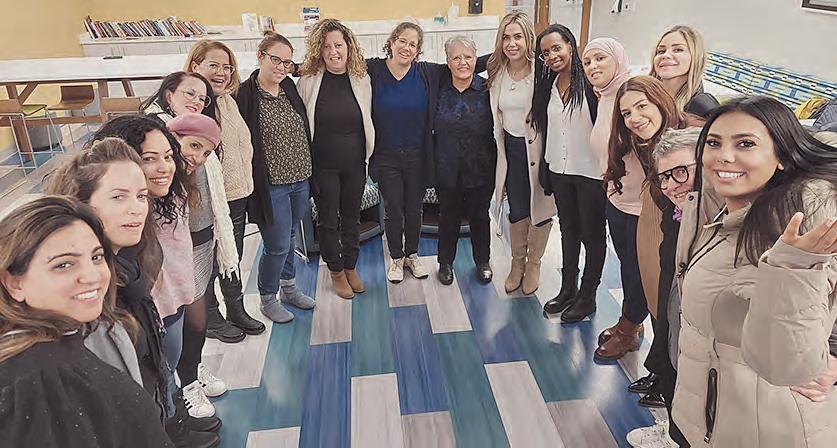
The MA in Jewish Professional Studies
VAN DE KAMPWRIGHT Jewish Press Editor
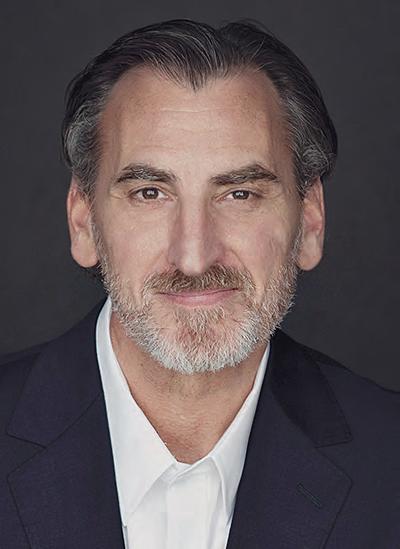
The Chicago-based Spertus Institute for Jewish Learning & Leadership provides targeted training for professionals who work for Jewish organizations across North America. Key among Spertus Institute’s Leadership programs is the MA in Jewish Professional Studies program, an acclaimed graduate program in which students gain the skills to advance both their careers and communities. Graduates bring new competencies, creativity,
and credentials to organizations across the spectrum of Jewish life.
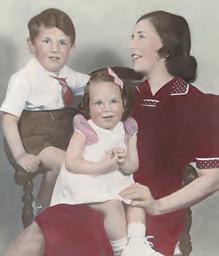
both synchronous online learning and in-person seminars at Spertus Institute’s award-winning downtown Chicago campus.

Leigh previously received her certificate for Jewish leadership through the Spertus Institute, which she accomplished during the fall of 2020.

Bob’s Jam
The Jewish Federation of Omaha is counting down until we can welcome Bob Goldberg as our new CEO. While some of us, and some of you, have known Bob for many years, others have not yet had the pleasure. So, for the coming months, Bob will share short insights into who he is. This way, we get all get (re-)acquainted. If you have specific questions for Bob, feel free to email them to avande kamp@jewishomaha.org. For this third installment, Bob remembers BBYO and AZA.
This year’s list of Jewish community professionals includes a familiar name: Leigh Chaves, Israel Engagement and Outreach Director for the Jewish Federation of Omaha.
Together, these students will learn from skilled faculty members with extensive real-world experience. Coursework bridges theory and practice, providing content that students can immediately apply in their work. The 30-month program includes
“All the classes were online, because of the pandemic,” Leigh said. “We had two one-week sessions, and I was aware there was an option for intensive follow-up study. Starting in my current position, I felt pursuing a degree like this would really benefit me.”
The cohort system fosters a network of colleagues who work closely with each other throughout the program — and often serve as resources for each other throughout their careers. Alyssa Dickman, Director of Spertus Institute’s Center for Jewish Leadership, worked with incoming students last week during the seminar that launched their program. She See Jewish Studies page 2
I am a proud member of AZA#1, as are my dad and my brother. AZA gave me some of my best, lifelong friends, and it saddens me that my last two communities (Fort Worth and Des Moines) no longer have a BBYO (B’nai B’rith Youth Organization) presence. We tried to bring it back to Fort Worth, but were unsuccessful. Some of the Fort Worth teens that wanted a BBYO experience had their parents drive the 30 minutes to Dallas so they could join a chapter there.
I was lucky that my brother, who is two years ahead of me in school, joined AZA and I was exposed to all of those guys two years before I was actually of age to join. I served as President of our chapter for two years and co-chaired two Sweetheart Dances (along with Brian Yampolsky and Michael Bloch), which were quite the events back in the day. Imagine young guys in tuxedos and cummerbands, the girls in beautiful dresses with corsages, and the whole to-do.
Our rivalry with Chaim Weitzman#1510 was legendary and made for great competition. There was also a strong AZA#100 chapter. So, there were three AZA chapters and two BBG (B’nai B’rith Girls) chapters. Beau dances, Sweetheart dances, Sunday meetings at the J, basketball leagues, the infamous nose bowl, and so many good times.
My buddies and my brothers from from AZA#1 include: my actual brother, Steve, Jeff Kirshenbaum, Alan Widman, Bennett Ginsberg, Randy Greenberg, Mark Passer, Jason Franklin, Lynn Polonski, Brian Yampolsky, David Kaslow, Corey Kaplan, Rich Rosenblatt,
DECEMBER 16, 2022 | 22 KISLEV 5783 | VOL. 103 | NO. 10 | CANDLELIGHTING | FRIDAY, DECEMBER 16, 4:37 P.M. The shammes of B’nai Israel Page 3
movie
Independence Page 5 Shine
Page 6 The Jewish Press WWW.OMAHAJEWISHPRESS.COM | WWW.JEWISHOMAHA.ORG SPONSORED BY THE BENJAMIN AND ANNA E. WIESMAN FAMILY ENDOWMENT FUND AN AGENCY OF THE JEWISH FEDERATION OF OMAHA
Spotlight 7 Voices 8 Synagogues 10 Life cycles 11 INSIDE
Israel condemns Netflix
about 1948 War of
A Light campaign responds to rise in antisemitism
REGULARS
LEIGH CHAVES
See
Jam page 3
Bob’s
ANNETTE
Bob Goldberg
Conversations for Change
ANG BENNETT
Inclusive Communities Communications Manager
Partnership unites women
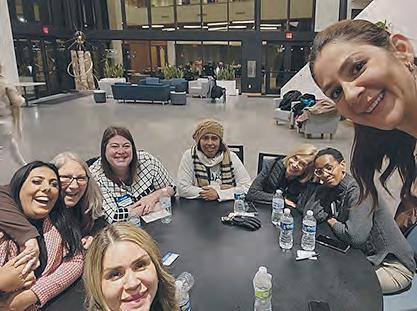
Continued from page 1
Community
over to tour AMI.
For our Israeli guests, this trip was “once in a lifetime”. Participant Adi Yarimi Leibovich wrote, “It has been a little over a week since our journey together ended... I keep remembering, sharing, and describing what we experienced to anyone who asks (sometimes even to those who don’t ask). I have no doubt we are truly a mission of sanity, courage, and strength”.
Safi Biromi, another Israeli participant, wrote, “I came to the delegation with a lot of concerns and fears, both in relation to exposing myself and sharing the complexity we live in... however, very quickly these concerns faded away and were replaced by feelings of belonging”.
Our wonderful host families opened their
homes and hearts to our guests, and bonds were quickly made. I heard much talk of “when are you coming to Israel to visit us?” when leaving their host homes.
Thank you to our host families, Zoë Riekes, Friedel Jewish Academy, The Schwalb Center for Israel and Jewish Studies at UNO, Scott Littky, our friends at Tri-Faith and American Muslim Institute, Star Catering, and all of the community members who joined us for events. This program was generously sponsored by the Staenberg Family Foundation, the Kiewit Companies Foundation, and the Shirley and Leonard Supporting Foundation – thank you!
Please save the date for the Jane H. and Rabbi Sidney H. Brooks Conversations for Change Series, a new program that Inclusive Communities is launching in March 2023. Thanks to a gift donation from their daughter, Miriam, the series will be an annual free-tothe-public event that will continue her parents’ legacy of teaching through dialogue and building bridges between different cultures and identities.
This year’s fireside chat will feature actor, writer, producer, and former Associate Director of the White House office of Public Engagement, Kal Penn. Kal’s memoir, You Can’t Be Serious, highlights the challenges he faced growing up as South Asian in New Jersey, and the obstacles to succeeding in Hollywood without being typecast.
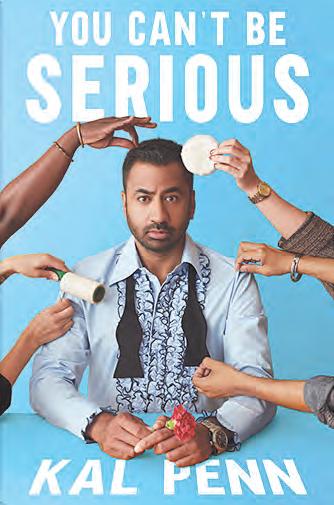
Stay tuned for more details!
Jewish Studies
Continued from page 1 said, “It’s been a pleasure to see these enthusiastic professionals come together, sharing their ideas, goals, and the challenges they encounter in their careers. As a group, they bring a wealth of experiences from organizations across the Jewish nonprofit sector — and they are embracing the opportunity to learn from each other, as well as with each other.”
In November of this year, Leigh traveled to Chicago to complete the first session of the 30-month program. Three in-person sessions mean completing graduate classes in a five-day period. While she pursues her MA, she continues to work full-time.
“Topics range from management and supervision skills to Jewish content,” Leigh said. “There is a lot of material to go through, so I often spend my lunchbreaks reading, and I
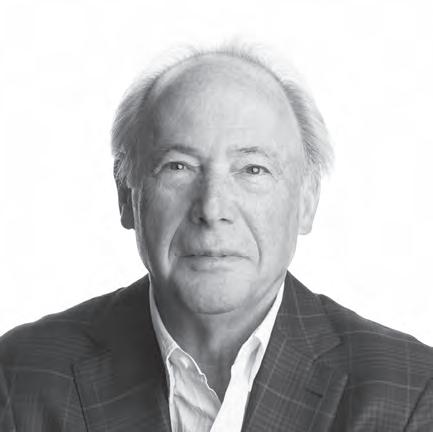
listen to the audio while I’m driving. I squeeze it in whenever I can find a free moment!”
She is most excited about the new knowledge she will gain, she said. “With all this new knowledge comes growth and confidence, the ability to connect with other Jewish professionals around the country, and that is something I am passionate about. Even if it takes me until May of 2025 to graduate, I can’t wait to see everything I will learn from this program.”
The MA in Jewish Professional Studies is a program of Spertus Institute's Center for Jewish Leadership, supported in part by a generous grant from the Crown Family. Spertus Institute is a partner with the Jewish United Fund in serving our community.
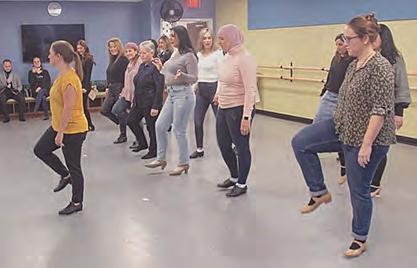
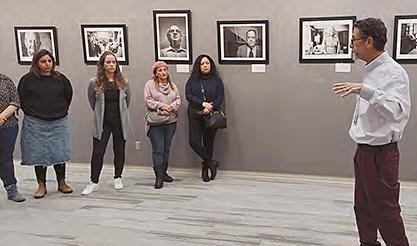
The Jewish Federation wishes Leigh good luck; we have no doubt she will make the most of this opportunity.
There are many ways to support Israel and its people, but none is more transformative than a gift to Magen David Adom, Israel’s paramedic and Red Cross service. Your gift to MDA isn’t just changing lives — it’s literally saving them — providing critical care and hospital transport for everyone from victims of heart attacks to casualties of rocket attacks.
Support Magen David Adom by donating today at afmda.org/support or call 866.632.2763.

2 | The Jewish Press | December 16, 2022 News LOCAL | NATIONAL | WORLD
No charitable gift has a greater impact on the lives of Israelis.
afmda.org/support
Church. Attendees heard about the Tri-Faith model from Executive Director Wendy Goldberg, and had impactful table discussions. The group then walked
The shammes of B’nai Israel
Many years ago there were two large traditional Orthodox synagogues in Omaha, both downtown, both occupied sizable brick buildings, and both friendly rivals. Years later they merged and became Beth Israel Synagogue.
One on the corner of 18th and Chicago was B’nai Israel though everyone called it “the Rushishe Shul” since most of its member came from what was then called “Russia” though is now actually Ukraine. The other synagogue was on the corner of 19th and Burt and was officially called Beth Hamigdosh Hagadol though everyone called it “the Litvishe Shul” since its members mostly came from Lithuania.
The Litvishe Shul faced east as most traditional synagogues did. But the Rushishe Shul faced south. No one could explain why it was originally built that way. But it made a compromise by creating a chapel for daily services in its basement with the door for everyday use opening directly to the east so every congregant attending daily services entered facing east and faced east during services.
When I was a young boy, in the days before World War II when my father was away from home for three years while serving as an Army Captain, my parents belonged to Temple Israel, the Reform synagogue. My parents also held memberships in the two Orthodox shuls where they had grown up; my mother in the Litvishe Shul and my father in the Rushishe Shul.

The families joked at the time of their marriage in 1932 that it was in fact “really an inter-marriage after all.”


My father regularly observed yahrzeit for his father at the Rushishe shul.
I remember having him take me when I was about five to the early morning service. It was cold and in January. We entered through the door on the west side of the building’s basement and were immediately in the chapel with seats facing east in double rows. Men were already seated and wearing their tallis and tefillin. A man they all knew was walking around and greeting everyone. He was what seemed to me to be an older man. They all called him the shammes, and he

was clearly in charge. He had his tallis and tefillin on and greeted my father cordially, but he ignored me.
The service began and about half way through it the shammes began walking around. Now and then he would approach one man, tap him on the shoulder and whisper something in his ear. I could never hear what he said, but I watched what he did. Then, within a few seconds, the man who was just tapped stood and walked to the small bimah, sort of a table with a velvet cloth covering it and where the torah was laying opened. The man said something, sort of singing it in Hebrew. I did not understand it. When the reader finished reading a short passage from the Torah scroll, the man who was tapped and called up sang a few more words and stood on the side of the table while a second man did the same thing. The shammes kept walking around, tapping and whispering, and the men who he tapped kept going up and reciting the same words.
My father was one of those who was tapped.
I then sat alone. I was petrified. The shammes kept walking around tapping men and whispering.
“What if he tapped me,” I worried to myself. I had no idea what to say. No idea what to do. I thought about getting up and leaving, but that would upset my father. I was near panic. Then the service was quickly over. Everyone returned to their seats and took their tallis and tefillin off, carefully folded each, and put them in small felt bags.
The Shammes came to my father and spoke with him. He liked my father. He smiled a lot and seemed like a friendly man. Up close he no longer frightened me. He pinched my cheek, called me by my name, and said he hoped I’d come again with my father. Moments before his warm words I was afraid. But once he began to speak, I too liked him, just like everyone at that morning minyan did.
That all took place more than 80 years ago. I wish I could remember the name of the shammes. Even though I remember being afraid of him, all of a sudden I liked him and his smile, his handsome white beard so carefully trimmed, his dark blue suit and vest, and the glow that engulfed him.
I still think of him, and I’ve never again, in all my 87 years, been afraid of a shammes.
Hanukkah, Israel, and antisemitism
The Maccabees were the heroes of the early Zionists, and their legacy is still very much alive and well in contemporary Israel. The Maccabean revolt against the Seleucid Empire in the 2nd century BCE, which is celebrated on Hanukkah, resulted first in semi-autonomy for Judea, and then, with the decline of the Seleucids, into the fully independent Hasmonean Empire for a period of about half a century (ending in 63 BCE when the Romans reduced it to a client state). In their fight for Israel, the early Zionists saw themselves as reasserting Jewish political independence after a period of 2000 years. A major sports club in Israel, seeking no doubt to promote a fighting spirit, is named “Maccabee” (similarly, the “Jewish Olympics” is called “the Maccabiah Games”), and the name is popular throughout Israeli culture; e.g., as the name of a beer and as the name of one of Israel’s three HMOs. With the most recent flare-up of the topic of antisemitism still echoing in the news (former President Donald Trump’s Nov. 22 hosting of Nick Fuentes and Kanye West at Mar-a-Lago), and with the Hanukkah holiday soon to begin, it’s worth noting differences in discourse on antisemitism between the Jewish State and the United States.
The United States seems to be caught up in a repetitive pattern whereby some celebrity or other makes an antisemitic statement (or promotes such statements), with the fallout being widespread condemnation, punishment (threatened or actual--such as the loss of a sponsorship deal), and with the celebrity walking back their statement (with educational help sometimes provided by Jewish leadership). So you have Kyrie Irving, a professional basketball player with the Brooklyn Nets, putting a link to an antisemitic film on an Oct. 27 Twitter post, him being suspended for a few games, him issuing an apology on Instagram, and a Nov. 21 New York Times interview with
Jonathan Greenblatt, chief executive of the Anti-Defamation League, who in light of the post, had met with Irving’s father and stepmother/agent.
It was apparently in response to contemporary events that musician John Cougar Mellencamp said, on Nov. 5 at the Rock & Roll Hall of Fame Induction Ceremony in presenting an award to Alan Grubman (whom he refers to as “my lawyer, my friend, and my rabbi”): “I’m an artist and a gentile, whose life has been enriched greatly by my friendship and association with countless Jewish people. Guys, I cannot tell you how f’ing important it is to speak out if you’re an artist against antisemitism, against all forms of hatred.”
Coincidentally, the day before, in the Nov. 4 issue of the Omaha Jewish Press (where almost a quarter-century ago my column got its start!!), Editor Annette van de Kamp-Wright wrote that she is “irritated and exasperated” not just by antisemitic comments made by celebrities such as Kanye West but also by the follow up from philosemitic non-Jews: “I’m not always grateful when non-Jews stand up for us. Sometimes I
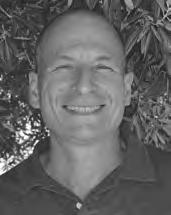
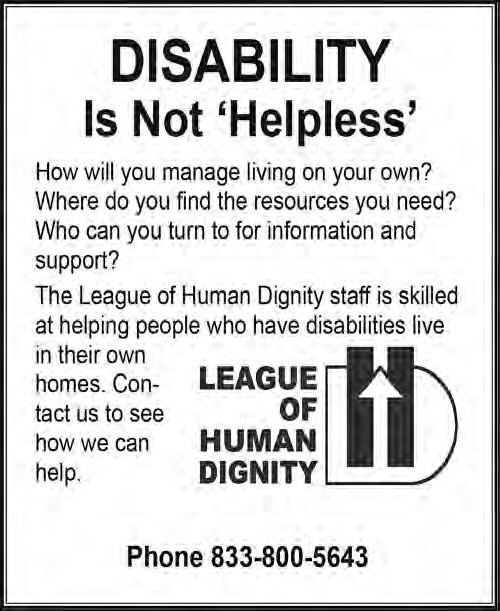
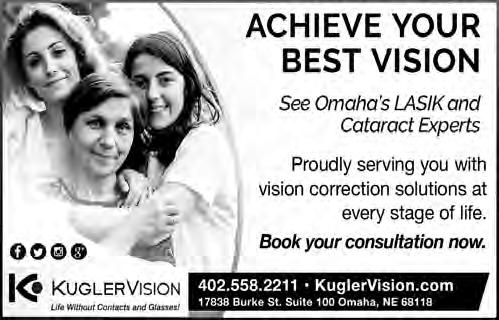
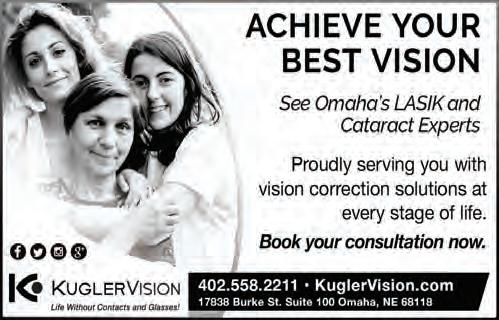
See Teddy Weinberger page 4
Bob’s Jam
Continued from page 1
Mark Rosenblum, Mark Horwich (of blessed memory), Brad Goldstrom, Danny Rips, Adam Rod, Robbie Simons, Mike Merritt, Michael Bloch, Tom Kahn, Marty Cohen, Steve Wasserman, Larry Widman, and many others.
There used to be an old framed black and white photo hanging on the wall of the J at the end of the hall with Sam Beber and the first group that started AZA in Omaha in 1924. It continues to be an amazing legacy of Omaha that such an impactful program that has provided experiences that have framed so many of our lives was created in our home town.
The Jewish Press | December 16, 2022 | 3 HIRO 88 WEST OMAHA LINCOLN 3655 N 129th St. 402.933.0091 601 R St. #100 402.261.9388 SUSHI | JAPANESE | CHINESE OLD MARKET 1308 Jackson St. 402.933.5168 MILLARD 17664 Welch Pl. 402.933.5168 www.Hiro88.com
RICHARD FELLMAN
TEDDY WEINBERGER
The Adventures of Ella Fleishman Auerbach
Ella Fleishman died 50 years ago at the age of 77. A first generation American, she was born on Feb. 26, 1894, in Omaha and died in Omaha on Jan. 18, 1972. She is buried in Beth El cemetery. She married Herman Auerbach in 1922 and had no children. Personal memories of Ella are confined to nephews and friends who are generally over 70. I discovered Ella around 1980 while researching Omaha Jewish peddlers and finding Ella’s two unique contributions, her 1928 138-page typescript Jewish Settlement in Nebraska and co-authored History of Nebraska Medicine (1930).
Ella’s posterity lies in two books and articles in the Central High School student newspaper Register, the Omaha Daily Bee, Omaha World-Herald, The Universal Jewish Encyclopedia, and American Hebrew, much of which is available online.
Jon Wine, her great nephew, observes her Yahrzeit with mourners Kaddish at his orthodox Beverly Hills synagogue and visits her grave when in Omaha. The three Goldstrom brothers, Larry, Mark and Jerry, hold cherished memories. Joshua Rubin, the great-great-great grandson of Abraham Fleishman, Ella’s grandfather, recently contacted me regarding the 1880s Fleishman Torah, more of which in a later episode.
The services accompanying the completion of Beth El synagogue’s renovation in October 2022 included the Book of Remembrance containing the names Ella Fleishman Auerbach and Herman Auerbach. Marty Shukert recalls delivering Kosher meat from his father’s store to Ella as his last stop on Thursday afternoons.
Tzedakah, endowing named awards, scholarships, museums, libraries, educational institutions, and hospitals are additional ways to enhance remembrance. Memory may be disrupted by remodeling, name changing or tearing down a building, and other hazards.

Ella led a remarkable life but did not remark much about it. She volunteered in France in 1919 to run a Jewish Welfare Board canteen serving the American Expeditionary Force. She and Herman visited the Soviet Union in 1937. She toured five continents. She received thousands of letters and typed thousands of letters, hardly any survive. Excavating her life is instructive and thought provoking.
The Jewish Press published a 40-word death announcement on Jan. 21, 1972:
“ELLA FLEISHMAN AUERBACH. Funeral services were held Wednesday, Jan. 19 for Ella Fleichman [sic] Auerbach of 601 S. 31st Street. Interment was at Beth El Cemetery. Survivors are: sister, Mrs. Anna Cherniss; brother, Dr. Max Fleishman and nieces and nephews.”
The Omaha World-Herald obit, Ella’s former employer, devoted 221 words to recalling her 1920 Council Bluffs Train Robbery scoop.
the familiar chain migration path. They arrived in New York, the east coast metropolis, and headed for the hinterland, Des Moines and Sioux City Iowa, where they might eke out a livelihood. Ella recounted, “Dad said he walked all the distance to South Dakota and back with his pack on his back.”
The 1887 and 1888 Sioux City directory identifies Esau Fleishman as a photographer. The Sioux City Journal tells a richer story of Esau’s commercial and Jewish leadership. He purchased a lot in 1886. Sophia and son Harry arrived in August 1887. Esau’s 1888 real estate transactions involved Nicholas Sokoloff, Joseph Mark and Belle Cohen in the Cohen & Marks’ addition.
Jewish New Year celebrations were announced in 1887 on the second floor of the Haakinson Block (Finnish owners). In 1888 “the Hebrews of Sioux City” celebrated at the Odd Fellows’ Hall. E. Fleishman managed both.
In Spring 1888, Esau advertised “Cash Paid for Old Clothes. Send word by postal card... and I will call. E. Fleishman.” In fall 1888 E. Fleishman Proprietor of St. Paul House, at 413 and 415 Second St., opposite Milwaukee Depot invited Corn Palace visitors to the “refitted and renovated... hotel and restaurant.”
Sioux City grew from 7500 residents in 1880 to 38,700 in 1890. Omaha however suggested more opportunities growing from 30,518 in 1880 to 140,452 in 1890, with a much larger Jewish community. The Missouri River, the longest in North America, connects Sioux City and Omaha. The Fleishmans could have taken a steamer, the railroad, or a wagon. The 93mile I-29 trip today is less arduous.
Esau’s father, Reb Abchek, Abraham (Abba) Fleishman was born in 1828. The 1891 Omaha city directory listed Abraham Fleischman as the Rabbi of Congregation B’nai Israel, in 1893 as a laborer and 1894 as a book agent. He died on March 3, 1894, five days after Ella’s birth. In 1891 renowned Rabbi Zvi Hirsch Grodzinsky (1857-1947) arrived in Omaha. Abraham’s widow likely gave her husband’s books to Rabbi Grodzinsky. She moved to St. Louis where her daughter lived.
Sophia’s father, Rabbi Noach Yaacov Hillman, was related to Sidney Hillman founder of the Amalgamated Clothing Workers of America, and to the highly placed Herzog rabbinical and political family.
The Omaha city directory for 1889 to 1923 listed Esau as a photographer, peddler, picture framer, retail butcher, real estate, and city meat inspector. Ella’s six page “Fleishman Family History as told by Ella Fleishman Auerbach – 1965,” stated “before Grandpa Fleishman died in 1894, it was decided that my Dad would go to New York to obtain ‘schimiches’ to succeed him as Shochet and Mohel.” Esau acquired credentials in six months. Returning to Omaha he became a pillar in the Jewish community. Ella claims her father between 1901 and 1913 welcomed 2,035 immigrants at the train station. Sophia ran a Kosher boarding house at 1919 Burt. She died in 1918. Esau remarried and died in 1934.
Sophia and Esau had five children who reached adulthood.
SNOWBIRDS
Ella’s immigrant parents, Esau Fleishman (1861-1934) of Birzai and Sophia (Beth Sheba) Hillman (1861-1918) of Posval, 12 miles away, married in 1882. They lived about 106 miles from Lithuania’s capital Vilnius.
The Fleishmans, Rabbi and son, in the early 1880s followed
Teddy Weinberger

Continued from page 3 am paranoid. I wonder why they are speaking out.” Annette goes on to relate the different perspectives between herself and her 21-year-old daughter to such comments as Mellencamp’s. Whereas Annette is suspicious, her daughter appreciates the non-Jewish support as a way of feeling less alone in a world not always friendly to Jews.

My reaction to such public expressions of support is different: I’m embarrassed by them. My embarrassment stems from the assumption by well-meaning gentiles such as Mellencamp that their remarks are necessary. Perhaps they are in America (Mellencamp received a standing ovation). Israelis on the other hand are guided by real politik when it comes to discourse on antisemitism. We are much more concerned with the political and economic relationships between us and a given country than we are with any antisemitic statements made in that country. [Though it is completely understood by all that should a particular country’s Jews be in physical danger, Israel will act to save them.] Indeed, the word “anti-
INFORMATION

Please let the Jewish Press know in advance when you are leaving and when you are returning. Sometimes several papers are sent to your “old” address before we are notified by the Post Office. Every time they return a paper to us, you miss the Jewish Press and we are charged! Please call us at 402.334.6448 or email us at jpress@jewishomaha.org.
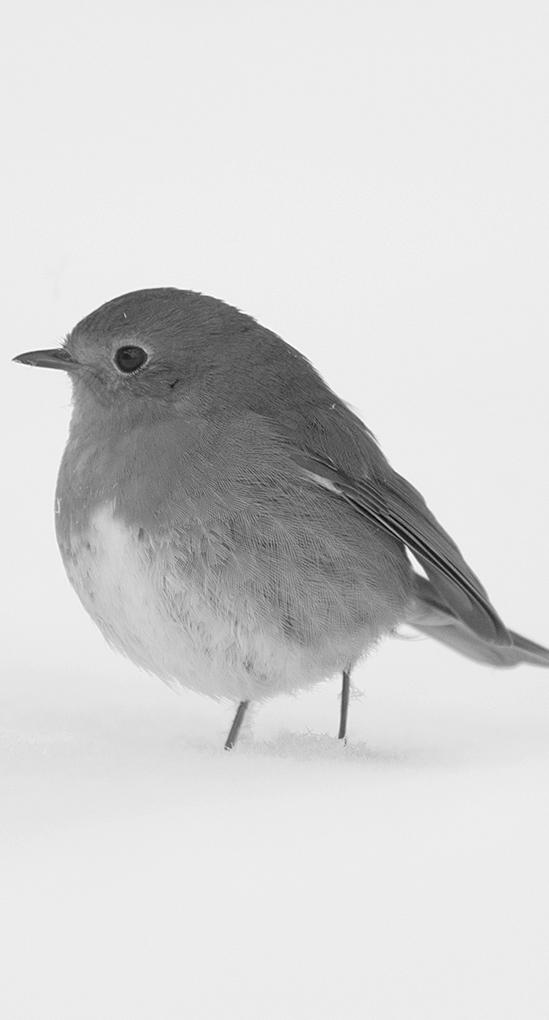
ANTISEMITIC/HATE INCIDENTS


If you encounter an antisemitic or other hate incident, you are not alone. Your first call should be to the Jewish Community Relations Council (JCRC) in Omaha at 402.334.6572, or email JCRCreporting@ jewishomaha.org. If you perceive an imminent threat, call 911, and text Safety & Security Manager James Donahue at 402.213.1658.
Harry G., (1882-1968) opened a store in North Platte. Samuel, (1889-1956) moved to Los Angeles. Anna (1893-1982) married Isaac N. Cherniss (1888-1960) in 1913. Ella married Herman H. Auerbach (1886-1948) in 1922. Max (1900-1993), the only offspring to attend college became a physician and never married.

semitism” hardly comes up in discourse here. Typically, the word is used only jokingly; e.g., “A few weeks ago I flew Air France to Paris. But the stewardess refused to give me a second glass of wine—antisemites.” Yes, it’s almost like Israeli culture goes out of its way to not take seriously incidents such as those surrounding Fuentes, West, and Irving.
Annette concludes her piece by saying: “Instead of feeling hurt because of what the antisemites think and say and do, I want to be happy in spite of it. I want to be strong and content and positive and I want to feel like I’m home in a vibrant and robust community with lots of Jews who are just as strong.” While I very much hope that Annette’s vision comes true throughout the United States, I can tell you that that’s the way I feel living here in Israel. Happy Hanukkah.
Teddy Weinberger, Ph.D., made aliyah with his wife, former Omahan Saraj Jane Ross, and their five children, Nathan, Rebecca, Ruthie, Ezra, and Elie, all of whom are veterans of the Israeli Defense Forces; Weinberger can be reached at weinross@gmail.com
ORGANIZATIONS
B’NAI B’RITH BREADBREAKERS
The award-winning B’NAI B’RITH BREADBREAKERS speaker program currently meets Wednesdays via Zoom from noon to 1 p.m. Please watch our email for specific information concerning its thought-provoking, informative list of speakers. To be placed on the email list, contact Breadbreakers chair at gary.javitch@gmail.com
4 | The Jewish Press | December 16, 2022 Tritz Plumbing Inc. 402-894-0300 www.tritz.com family owned and operated since 1945 repair • remodelcommercial • residential
OLIVER B. POLLAK
SIX: The hottest
“Can’t miss” show this season
The brilliant mind behind one of the hottest and most creative new Broadway shows this year belongs to a young Jewish-English writer and composer. Toby Marlow, along with friend Lucy Moss, turned the six wives of King Henry VIII into pop icons in the smash musical SIX Marlow and Moss were inspired by an old rhyme that helps British schoolchildren remember the order of the queens: “Divorced, beheaded, died, divorced, beheaded, survived.” The writers let each queen tell her story – while the six interact and compete over who had it worse, and alternatively, who was the best wife. From the music to the costumes and choreography, the whole production is stunningly innovative and unique.
Toby Marlow and Lucy Moss devised the original concept and started writing SIX when they were students at Cambridge University in early 2017. It was first presented with student actors at an arts festival, playing for a month before it was picked up by professional producers. The show has since become a global sensation – with worldwide tours and just this year, SIX: LIVE ON OPENING NIGHT Broadway album debuted at #1 on the Billboard Charts and surpassed 6-million streams in its first month.
SIX won 23 awards in the 2021/2022 Broadway season, including two Tony-Awards® for Best Original Score and Best Costumes. It’s still playing on Broadway, but you can see it at the Orpheum Theater in January. The show runs Jan. 38, 2023, with only eight performances, including weekend matinees. As of this writing, tickets are still available at tick etomaha.com

JEWISH PRESS NOTICES
The Jewish Press office is closed Monday, Dec. 26, for Christmas; the deadline for the Dec. 30 issue is Monday, Dec. 19, noon Questions? Call 402.334.6448.
Israel condemns Netflix movie about 1948 War of Independence
ANDREW LAPIN JTA
Israel’s government has lashed out at Netflix over a new Jordanian movie that they say disparages the country’s military and their actions in the War of 1948 that led to Israel’s independence.
Farha, Jordan’s entry into the Academy Awards’ best international feature race, is a historical drama about the “Nakba,” or “catastrophe,” the Palestinian term for the events that led to the founding of the State of Israel. In the

But Israel has attacked the film and its producers over what the government says is an unfair portrayal of the IDF.
“To me, it is ridiculous that Netflix chose to release a film whose entire purpose is inciting mockery against IDF soldiers,” Israeli Finance Minister Avidgor Lieberman told Israeli media.
Lieberman further suggested the treasury could withhold state funding from the theater unless it canceled plans to screen the film, saying, “The choice of a cultural institution funded by
tion campaign against the film.
“These attempts to silence our voices as Semite/Arabs and as women filmmakers to dehumanize us and prevent us from telling our stories, our narrative and our truth are against any freedom of speech,” reads the statement by Sallam and producers Deema Azar and Ayeh Jadaneh.
Another film that has provoked controversy over its depiction of the events of 1948, the Israeli documentary Tantura, opened in U.S. and Palestinian the-
film, a Palestinian teenager locked in a storage room witnesses a family being slaughtered by the Israel Defense Forces. Two small children and a baby are among the victims.
The movie debuted on Netflix on Dec. 1, and Al Saraya Theatre, a theater in Jaffa popular among Arab Israelis, planned to screen it. Its director, Darin Sallam, has said she based the film off twice-removed real-life testimony from a Palestinian refugee of 1948 who ended up in Syria.
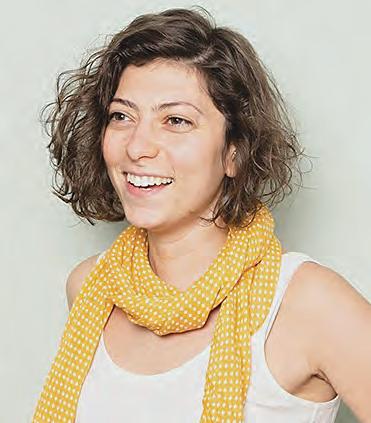
Israeli law permits the finance minister to withhold funding from any cultural institution that recognizes the Nakba by commemorating Israel’s Independence Day as a day of mourning.
Outgoing Culture Minister Chili Tropper also criticized the film, saying it makes “false plots against IDF soldiers.”
In response, producers of Farha released a statement accusing the Israeli government of launching a disinforma-
aters this week. Tantura plays oral testimony from former members of the Israeli military who recall slaughtering hundreds of Palestinian residents of the village of Tantura and dumping their bodies into mass graves to pave the way for a kibbutz.

A theater in Ramallah in the West Bank is currently showing Tantura, which its distributors say marks the first time a theater in the Palestinian territories has shown an Israeli documentary.
•
•
•
•
•
•
The Jewish Press | December 16, 2022 | 5 News LOCAL | NATIONAL | WORLD
Interested? Send your application to Avandekamp@jewish omaha.org today. We cannot wait to meet you! The Jewish Press is looking for a full-time sales manager, with the following responsibilities:
Print and digital sales
FULL-TIME SALES MANAGER
•
Digital Content development
Tracking sales goals and reporting results
as necessary
•
Promoting the organization and products The Jewish Press
Requirements:
Previous experience in a sales-related role is
a plus
•
Familiarity with website management
Great customer service skills
•
Excellent written and verbal communication
skills
•
the State of Israel to screen the abovementioned film is already unacceptable.”
Farha is Jordan's entry into the Oscars. Credit: Screenshot from YouTube
Farha Director Darin Sallam
Shine A Light campaign responds to rise in antisemitism



 PAM MONSKY JCRC Assistant Director
PAM MONSKY JCRC Assistant Director
Shine a Light is an international, December-long campaign intended to respond in solidarity to the dramatic rise of antisemitism, racism, and all forms of hate. As our community gears up for Hanukkah, the Festival of Lights, let’s spread the light of the season to dispel the darkness. Omaha’s Jewish Community Relations Council (JCRC) works to unite our Jewish community with allies in one positive voice as we are all stronger united than we are when divided.
With the recent rise of concerns around high-profile antisemitic statements and events, we are fielding numerous inquiries about how to respond to antisemitism locally and nationally. To help you better address antisemitic incidents and questions, we have put some valuable, trusted resources on our website: www.jewishomaha.org/jcrc/jcrc-details/
When we encounter antisemitism locally, the JCRC responds immediately. We assess the incident and report it to the proper authorities and the ADL. We provide education
about antisemitism in schools, workplaces, and wherever we are needed. We call out and expose antisemitism whenever and wherever it happens.
You can join the effort. We encourage you Shine A Light on your social media. #ShineALight for love, justice, kindness, compassion, humanity, allyship, and community. Stand united against antisemitism, racism, and all forms of hate. To download social media images for #ShineALight, please visit https: //shinealighton.com/toolkit
ABOUT THE JCRC

As the public affairs voice of the JFO, the JCRC works in common cause with other religious, racial, ethnic, and civic groups to foster a just, democratic and pluralistic society. Guided by Jewish values, the JCRC








fights anti-Semitism, advocates, educates, collaborates, and mobilizes action on issues of importance to the Jewish community and community at large, and promotes the security of Israel and Jews everywhere.
To report incidents, please email jcrcreporting@jewish omaha.org


 KATIE BROMAN OCP Executive Director
KATIE BROMAN OCP Executive Director
The Omaha Community Playhouse (OCP) will be among the first community theaters in the country to produce Beautiful: The Carole King Musical. This iconic musical will be the first production on the Hawks Mainstage Theatre in the 2023/24 season – OCP’s 99th season. Showdates are from Sept. 15-Oct. 15, 2023.







Tony Award winner Beautiful The Carole King Musical is the inspiring true story of singer/songwriter Carole King’s remarkable life, her journey to fame, and the mammoth impact she and her work had on the music industry. While not without strife and heartache, King’s story and unbreakable spirit will capture your heart. With songs like Will You Love Me Tomorrow, One Fine Day, and, of course, (You Make Me Feel Like) A Natural Woman, Carole King’s music is the soundtrack of a generation.
The remainder of the 99th season will be revealed in March 2023. Season subscriptions will be available at that time; Beautiful The Carole King Musical will be included in season subscriptions. Single tickets will go on sale summer 2023. Auditions for the show will be held in summer 2023 and will be open to all members of the community.





 JEWISH PRESS READERS
JEWISH PRESS READERS

If you do business with any of our advertisers, please tell them you saw their ad in the Jewish Press. It really helps us!

6 | The Jewish Press | December 16, 2022 News LOCAL | NATIONAL | WORLD JANUARY 3-8 | ORPHEUM THEATER | TICKETOMAHA.COM ARAG
C AST
B
DREW W ECC LES
ON OUR
PHOT OS
Y AN
us on
Visit
facebook: www.facebook.com/ShalomahaPress
SP O TLIGHT
PHOTOS FROM RECENT JEWISH COMMUNITY EVENTS













The Jewish Press | December 16, 2022 | 7
GENEROUSLY SUPPORTED BY
SUBMIT A PHOTO: Have a photo of a recent Jewish Community event you would like to submit? Email the image and a suggested caption to: avandekamp@jewishomaha.org
On Tuesday, Nov. 29, three Rose Blumkin Jewish Home employees received the annual Jack and Sonia Schrager 2022 Employee of the Year award. These winners consistently exceed expectations and make RBJH a better place. Chris Ulven, Executive Director, acknowledged how challenging it was to choose three winners out of several dozen nominees. They inspire others with their positive attitude and good work ethic and rarely miss a shift—Mazel Tov to the winners. Clockwise from above: Jennifer Stoneking, RN (21 years of service); Peter Casey, Cook, and Aaron Dittmer, Facilities & Grounds Coordinator (ten years).
Top, above and below: PJ Library Challah Tots and Havdalah in Pajamas.
Top, above, below and bottom: RBJH staff wants to thank Marvin Kohll and his family for sponsoring the scrumptious staff food day to celebrate Marvin’s 92nd Birthday. A meal from El Basha, Mediterranean Grill, was served to the staff of all three shifts.
The Jewish Press
(Founded in 1920)
Margie Gutnik President Annette van de Kamp-Wright Editor Richard Busse Creative Director Lori Kooper-Schwarz Assistant Editor Gabby Blair Staff Writer Sam Kricsfeld Digital support Mary Bachteler Accounting
Jewish Press Board
Margie Gutnik, President; Abigail Kutler, Ex-Officio; Seth Feldman; David Finkelstein; Ally Freeman; Mary Sue Grossman; Les Kay; Natasha Kraft; Chuck Lucoff; David Phillips; and Joseph Pinson.
The mission of the Jewish Federation of Omaha is to build and sustain a strong and vibrant Omaha Jewish Community and to support Jews in Israel and around the world. Agencies of the JFO are: Institute for Holocaust Education, Jewish Community Relations Council, Jewish Community Center, Jewish Social Services and the Jewish Press
Guidelines and highlights of the Jewish Press, including front page stories and announcements, can be found online at: www.jewishomaha.org; click on ‘Jewish Press.’
Editorials express the view of the writer and are not necessarily representative of the views of the Jewish Press Board of Directors, the Jewish Federation of Omaha Board of Directors, or the Omaha Jewish community as a whole. The Jewish Press reserves the right to edit signed letters and articles for space and content. The Jewish Press is not responsible for the Kashrut of any product or establishment.
Editorial
The Jewish Press is an agency of the Jewish Federation of Omaha. Deadline for copy, ads and photos is: Thursday, 9 a.m., eight days prior to publication. E-mail editorial material and photos to: avandekamp@jewishomaha.org ; send ads (in TIF or PDF format) to: rbusse@jewishomaha.org
Letters to the Editor Guidelines
The Jewish Press welcomes Letters to the Editor. They may be sent via regular mail to: The Jewish Press, 333 So. 132 St., Omaha, NE 68154; via fax: 1.402.334.5422 or via e-mail to the Editor at: avandekamp@jewishomaha.org.
Letters should be no longer than 250 words and must be single-spaced typed, not hand-written. Published letters should be confined to opinions and comments on articles or events. News items should not be submitted and printed as a “Letter to the Editor.”
The Editor may edit letters for content and space restrictions. Letters may be published without giving an opposing view. Information shall be verified before printing. All letters must be signed by the writer. The Jewish Press will not publish letters that appear to be part of an organized campaign, nor letters copied from the Internet. No letters should be published from candidates running for office, but others may write on their behalf.
Letters of thanks should be confined to commending an institution for a program, project or event, rather than personally thanking paid staff, unless the writer chooses to turn the “Letter to the Editor” into a paid personal ad or a news article about the event, project or program which the professional staff supervised. For information, contact Annette van de Kamp-Wright, Jewish Press Editor, 402.334.6450.
Postal
The Jewish Press (USPS 275620) is published weekly (except for the first week of January and July) on Friday for $40 per calendar year U.S.; $80 foreign, by the Jewish Federation of Omaha. Phone: 402.334.6448; FAX: 402.334.5422.
Periodical postage paid at Omaha, NE. POSTMASTER: Send address changes to: The Jewish Press, 333 So. 132 St., Omaha, NE 68154-2198 or email to: jpress@jewishomaha.org
Superheroes
ANNETTE VAN DE KAMP-WRIGHT Jewish Press Editor
Except for the occasional scuffle between football (soccer) players, followed by a yellow card, I don’t watch any fighting. Nothing against it, it’s just not my thing. No wonder I had never heard of Natan Levy.
Turns out, he is one of very few Israelis ever to compete in the mixed martial arts Ultimate Fighting Championship, or UFC. Levy was born in France, moved to Israel as a young child and brings an Israeli flag to all his UFC fights. That makes him super-cool.

“I am Jewish, it’s what I am, it’s how I was born,” Levy said during a post-fight interview. “I’m very proud of it and I will fight for it. I will fight for my people in the octagon, or wherever need be, and I will not stand for antisemitism. I won’t stand for any racism — not around me. Don’t bully anybody around me, or I’m going to find you.”
I recently spent a little too much time checking up on white supremacist Nick Fuentes. Know your enemy, and all that; it’s a rabbit hole, because when you read about one, ten more spring up in the reference section and before you know it, you walk away from your computer thinking half the country belongs to the alt-right. It’s depressing.
So when I saw the picture of Levy with his flag, I clicked the link. Here’s an athletic guy, with tattoos and big muscles, standing in the ring all sweaty and intimidating, holding an Israeli flag. Like a modernday superhero who walked straight off the pages of
A
a comic book. Unapologetic, confident, proud, and just a touch arrogant. It is a really welcome distraction from all the Kanye West headlines, because, seriously, I’m sick of hearing from him and about him. Let’s focus on Jewish heroes instead— it’s that time of year anyway. Judah Maccabee would approve.
First off, do we really need a hero? Yes; yes, we do. Much like the Maccabees back in the day, we’re surrounded by people who would like us to stop being Jewish, who want to do us harm and at the very least put us ‘in our place.’
My daughter told me: “Even if we did hold all the money and power antisemites think we do, we’re still broken and still need heroes and Maccabees. Non-Jews don’t always understand that.”
Here’s the thing though: if we really want heroes, we should probably step up and show up ourselves. Why wait for others to be heroic for us, when we can be so ourselves? What would it take to become our own heroes, rather than relying on somewhat random public figures? After all, our Judaism is not a passive proposition. Being Jewish means doing the work, it means taking action. So watching a muscular Israeli UFC fighter wave an Israeli flag is cool and inspiring, but only holds value if we also step into the metaphorical ring.
Antisemitism is bad and it’s getting worse all the time. There has been plenty of handwringing going
around; it is time to move forward and get to work.
Jewish pride is not just a feeling, it is much more than that. It is lighting candles on Friday night, it is helping out at your synagogue, it is praying, wel-
coming others, celebrating every day, donating to Jewish and non-Jewish causes; it means teaching our children and ourselves and it means never giving up. Our collective response to adversity should always include one more mitzvah.
We need heroes? Let’s be those heroes.
Black writer explores how Germany remembers its ‘unthinkable’ past
ANDREW SILOW-CARROLL JTA
For his 2021 book How the Word Is Passed, winner of the National Book Critics Circle Award for Nonfiction, poet and journalist Clint Smith explored the landscape of American memory — specifically how the history of slavery is explained, commemorated, distorted and desecrated in sites across the United States.

While on tour promoting the book, he explained in an interview Tuesday, he’d often be asked if any country had gotten it right when it came to memorializing its own dark past. “I kept invoking the memorials in Germany, but I had never been to the memorials in Germany,” Smith said. “As a scholar, as a journalist, I felt like I had to do my due diligence and excavate the complexity and the nuance, and the emotional and human texture, that undergirds so many of these places and spaces.”
The result is December’s cover story in the Atlantic, Monuments to the Unthinkable. Smith traveled to Germany twice over the past two years, visiting Berlin’s Memorial to the Murdered Jews of Europe, its Topography of Terror Museum, the museum in Wannsee where the Nazis plotted the Final Solution, and the concentration camp at Dachau, talking to historians and curators along the way. As a Black man wrestling with how America accounts for the crimes of its past, he went to learn from the experience of the Germans, who “are still trying to figure out how to tell the story of what their country did, and simultaneously trying to figure out who should tell it.”
In an interview, Smith talked about the inevitable differences between the Holocaust and the Atlantic slave trade, the similarities in how two countries — and communities — experience their histories, and how his article could serve as a bridge between African-Americans and Jews in a time of increasing tension between them.
Smith spoke to JTA from his parents’ home in his native New Orleans.
This interview was edited for length and clarity.
Jewish Telegraphic Agency: Your book is about the ways America succeeds and fails to come to terms with slavery, and your article is about the ways Germany is, in your phrase, “constructing public memory.” I was struck by
someone who warned you, “Don’t go to Auschwitz.” What were they saying?
Clint Smith: It was Frederick Brenner, a Jewish man and a remarkable photographer who has photographed the Jewish Diaspora across the world for the past several decades, who said that, because people are standing [at Dachau] and they’re taking selfies, and it’s like “me in front of the crematorium” and “me in front of the barracks.” That was deeply unsettling to him, especially as someone whose family was largely killed in the Holocaust.
I don’t want to be reductive about it and say that
places that carry the history of violence: plantations, execution chambers, death row. But I’ve never experienced the feeling in my body that I felt when I stood in the gas chamber at Dachau. And you just see the way that this space was constructed, with the sort of intentional, mechanized slaughter that it was meant to enact on people. The industrialized nature of it was something unlike anything I’d ever experienced before and it made me feel so much more proximate to that history in ways that I don’t think I would have ever experienced otherwise.
you don’t want people to go to these spaces and take pictures. I think it’s all about the sort of disposition and sensibilities one brings to a space. If someone went to the Whitney Plantation in Louisiana, I don’t necessarily want them doing puckered-lip selfies in front of a slave cabin. I can understand why people wouldn’t want those places engaged with in that way, but you do want tourists to come, right? I mean, before the pandemic, 900,000 people visited Dachau every year, and part of what brings people to Dachau is seeing and taking a picture of the crematorium, taking a picture of themselves on this land in that space where history happened, and posting it online. And maybe that serves as a catalyst for somebody else to make that journey for themselves.
You did go to Dachau, which you call a “memorial to the evil that once transpired there.”
I am a huge believer in putting your body in the place where history happened. I stood in many
Physically standing in a concentration camp and physically standing and putting my body in the gas chamber fundamentally changed my understanding of the emotional texture and the human and psychological implications of it. Because when you’re in those spaces you’re able to more fully imagine what it might have been like to be in that space. And then you can imagine these people, these families, these women, these children who were marched into camps throughout Europe. You can never fully imagine the fear, that sense of desperation that one would have felt, but in some ways, it’s the closest we can get to it if you are someone who did not have family who lived through or survived the Holocaust. It provided me with a radical sense of empathy. And that’s why I took the trip in the first place.
By contrast, there are the memorials that are not historical sites, but either sculptural or architectural, like Berlin’s Memorial to the Murdered Jews of Europe, nearly five acres of concrete slabs. What do you think makes an effective memorial that isn’t necessarily the historical place itself, but a specifically memorial project?
Well, for example, the big one in Berlin. It’s just so enormous. The scale and scope of it was unlike anything I’d ever seen before. I tried to imagine what an American analog would be like. What if in the middle of downtown Manhattan there was a 200,000-square-foot memorial, with thousands of stone columns, dedicated to commemorating the lives of indigenous people who were killed in the early Americas? Or a 200,000-square-foot memorial in the middle of downtown D.C., not far from the White House, to the lives of enslaved people? See A Black writer explores page 9
Nebraska Press Association Award winner 2008 American Jewish Press Association Award Winner National Newspaper Association 8 | The Jewish Press | December 16, 2022 Voices
Editorials express the view of the writer and are not necessarily representative of the views of the Jewish Press Board of Directors, the Jewish Federation of Omaha Board of Directors, or the Omaha Jewish community as a whole.
Clint Smith is the author of December’s cover story in the Atlantic, Monuments to the Unthinkable, exploring how Germany — and by extension, the United States — accounts for the crimes of its past. Credit: the Atlantic
Natan Levy proudly shows an Israeli flag before his matches. Credit: Amy Kaplan
A Black writer explores how Germany remembers its ‘unthinkable’ past
Continued from page 8
With that said, what I found really valuable were the people I spoke to, who had very different relationships to that space. Some thought of that memorial as something that was so meaningful because of its size and because of its scope, and because it was a massive state-sanctioned project. And then there were others who thought that it was too abstract, that it was too passive, even in its name, right, the “Memorial to the Murdered Jews of Europe,” which sounds as if something happened to people without naming the people who enacted the harm and who committed the crime. Those are the sort of nuances and complexities that I wanted to spend more time with, and found really valuable because, in the same way, descendants of enslaved people here in the United States have many different conceptions of what the iconography of slavery should look like or what repair and reparations to slavery should be made.
You write about the “stumbling stones” or “Stolpersteine”: Those are the small brass plaques placed in the streets, inscribed with the names of Holocaust victims and placed in front of their last known residence. The stones are exactly the opposite scale of the Berlin memorial. Right. I think that is the memorial that I was most struck by: the largest decentralized memorial in the world, with 90,000 stones across 30 different European countries. I remember the moment I was walking down the street looking for landmarks and saw my first Stolpersteine, and I only saw it because at that moment the clouds moved and the sun shone off the brass stone. You see the name, the birth date, the deportation date, the death date, the place where the person was killed. You walk past another home, you see seven; you walk past another home, you see 12. You begin to imagine entire lives based on the names and information that exist on these stones. It creates this profound sense of intimacy, this profound sense of closeness to the history and it’s so human, because it’s individual people and individual names.
and suddenly antisemitism is gone. Obviously, Germany is a case study and is experiencing its own rise in antisemitism. And that’s something that’s deeply unsettling, and is not going to singularly be solved by memorials and monuments.
ingfully engage in repair to the descendants of communities that were harmed from some of the policies that existed there.
This is not to say that those programs themselves are perfect. But I think we sometimes talk about it so much on a federal level, that we forget the local opportunities that exist.
Many people who were redlined or experienced housing covenants — all the sort of insidious manifestations of wealth extraction that were part of Jim Crow — are still alive today.
So sometimes it’s not even a question of what you have to give the descendants. Sometimes it’s like, what do you give the actual people who are still here?
That’s an important distinction you make in your article, about the difference between grappling with the past in Germany and the United States. In Germany, there are so few Jews, while in the U.S. we see the living evidence of slavery, not the evidence of absence.
With that said, I think there is something to be said to regularly encounter physical markers and manifestations of the violence that has been enacted and crimes that have been done in your name, or to the people that you are the descendant of. I try to imagine Germany without any of these memorials and I think it would just be so much easier for antisemitism to become far more pervasive. Because when your landscape is ornamented by things that are outlining the history that happened there, it is much more difficult to deny its significance, it is much more difficult to deny that it happened, it is much more difficult not to have it shape the way you think about public policy. I do believe that if we had these sorts of markers in the United States, it wouldn’t solve the racial wealth gap, it wouldn’t solve racism, it wouldn’t solve discrimination. It wouldn’t eradicate white nationalism or white supremacy. But I do think it would play some role in recalibrating and reshaping our collective public consciousness, our collective sense of history in ways that would not be insignificant.
That’s perhaps the greatest difference that allows for both a landscape of memory to be created in Germany, and also allows for Germany to pay reparations in ways that the United States is reluctant to do: Jewish people in Germany represent less than one quarter of one percent of the population of Germany. One of the folks I spoke to told me that Jewish people in Germany are a historical abstraction. Because there’s so few Jewish people left, because of the slaughter of the Holocaust.

I think about the reparations that were given to Japanese Americans who were held in incarceration camps during World War II. They got $20,000 checks, which is not commensurate with what it means to be held in a prison camp for multiple years, and cannot totally atone for that. But part of the reason that can be enacted is that there’s a limited amount of people. There are 40 million black people in this country. So the economic implications of reparations are something fundamentally different here in the United States.
So let me ask you if there’s anything else you wanted to mention that we haven’t talked about.
One of the most valuable things about the stumbling stone project, I think, is all the work that precedes it. It’s the school students who are doing research to find out about the lives of the people who were taken from the home across the street from their school. It’s the people in the apartment complex, who come together and decide that they’re going to figure out who were the Jewish families who lived in that apartment complex before them. And sometimes it’s really remarkable, granular details about people’s lives: what their favorite food was, what their favorite flavor of ice cream was, what the child liked.
As Gunter Demnig, the originator of the project, says, 6 million people is a huge abstraction, and now it becomes about one man, one woman, one child, and [people] realize that it truly was not that long ago. There are so many survivors of the Holocaust who are still with us. Gunter Demnig, his father fought for the German army. He represents this generation of people who are engaging in a sort of contrition for the acts of their parents and their grandparents.
You ask in the piece what it would look like for a similar project to be created in the United States as a memorial to enslaved people.
I’m from New Orleans, and the descendant of enslaved people in New Orleans, which was at one point the busiest slave market in the country. And as Barbara Steiner, a Jewish historian, said to me in Germany, entire streets [of New Orleans] would be covered in brass stones! That was such a striking moment for me. That helped me more fully realize the profound lack of markers and iconography and documentation that we have to enslaved people in our landscape here in the United States relative to that of Germany.
Why are physical monuments important? I have sometimes wondered why we spend so much money on the infrastructure of memory — statues, museums, memorials — and if that money could be better used for living memorials, like scholarships for the descendants of victims, say, or programs that study or archive evidence of genocide. Why is it important to see a statue or a museum or even a plaque?
First off, museums and statues and memorials and monuments are by no means a panacea. It is not the case that you put up some memorials or you lay down some Stolpersteine

And to your point, my hope is that those things are never mutually exclusive. It’s a conversation that’s happening here in the United States with regard to how different institutions are accounting for their relationship to slavery. Universities are coming up with reports, presentations, panels and conferences that outline their relationship to the history of slavery, especially since the murder of George Floyd [in 2020]. Activists and descendants have pushed them to not just put out a report, or put up a plaque or make a monument. It’s also about, well, what are you going to do for the descendants of those people? Harvard, where I went to grad school, put $100 million aside specifically for those sorts of interventions. Places like Georgetown have made it so that people who were the descendants of those who are enslaved have specific opportunities to come to the school without paying. And people of good faith can disagree over whether those initiatives are commensurate with or enough to atone for that past, and I think the answer is almost inevitably no.
Certainly people on what we like to think of as the wrong side of history understood the importance of physical monuments in creating memory.
The origin story of my own book was that I watched the monuments come down in 2017, in my hometown in New Orleans, of Jefferson Davis, Robert E. Lee. I was thinking about what it meant that I grew up in a majority Black city, and there were more homages to enslavers than there were to enslaved people. What does it mean that to get to school I had to go down Robert E. Lee Boulevard? That to get to the grocery store, I had to go down Jefferson Davis Parkway? That my middle school was named after a leader of the Confederacy? And that my parents still live on a street today named after someone who owned 115 enslaved people? The names and iconography are reflective of the stories that people tell and those stories shaped the narratives that communities carry. And those narratives shape public policy and public policy is what shapes the material conditions of people’s lives.
One thing about Germany is that its national project of memory and repentance has been accompanied by a vast reparations program — for Israel, Jewish survivors, their families and programs to propagate Jewish culture. I wonder if you think Germany could have moved ahead without reparations? And can America ever fully grapple with the legacy of slavery without its own reparations?
The short answer is no. America cannot fully move forward from its past without reparations. The important thing is not to be limited and reductive in the way that we conceive of what reparations are or should look like. In some ways, I’m as interested if not more interested in what specific cities and states are doing in order to account for those histories and those crimes. For example, in Evanston, Illinois, they created a specific program to give reparations to Black families who experienced housing segregation, in a certain period of time, given how prevalent redlining was in and around Chicago in the mid-20th century. I know in Asheville, North Carolina, there’s a similar program that’s thinking about how to mean-
I want to name specifically for your readers that I’m not and would never intend to conflate slavery and the Holocaust. They are qualitatively different historical phenomena that have their own specific complexities and should be understood on their own terms. With that said, I do think it can be helpful to put the two in conversation with one another, specifically in the profound ways that these two monumental periods of world history have shaped the modern world and how they are remembered in fundamentally different ways. And there are similarities as well, which you write about.
I did find so many parallels. The Jewish people I spent time with in Germany explained that some of the manifestations of racism and anti-Blackness in the United States are not so different from the sort of manifestations of antisemitism that exist in Germany, especially as it relates to public memory. When I was at the museum devoted to the Wannsee conference, the executive director, Deborah Hartmann, told me that she and Deidre Berger [the chair of the executive board of the Jewish Digital Cultural Recovery Project Foundation] were talking about how Jewish people did not always have a seat at the table when these monuments and memorials were being built. Jewish people were not allowed to participate beyond a certain extent, because many Germans felt that Jewish people were not objective. Jewish historians couldn’t be taken seriously because they were too close to the history.
That just echoes so much of what Black scholars and historians have been told about their ability, or the lack thereof, to study the history of Black life. The godfather of African-American scholarship, W.E.B. Du Bois, was told by white scholars that he couldn’t be taken seriously because he was too close to the history of slavery.
Meanwhile, Deborah Hartmann talked about how so many of the historians and scholars who played a role in shaping the landscape of memory in Germany were themselves “close to the history,” including former members of the Hitler Youth.
Somebody sent me a message that really meant a lot to me this past week, basically saying that my essay is an exercise in “solidarity via remembrance” — in a moment where, unfortunately, there have been a lot of public manifestations of ideas and antisemitic remarks that might threaten to rupture a relationship between Black and Jewish people. Obviously, we didn’t time it this way: I worked on this piece for a year. But it’s my hope that as someone who is a Black American, who is the descendant of enslaved people, who is not himself Jewish — that my respectful, empathic, curious, journey reflects the long history of solidarity that has existed across Black and Jewish communities and that I hope we never lose sight of.
Andrew Silow-Carroll is editor in chief of the New York Jewish Week and senior editor of the Jewish Telegraphic Agency. He previously served as JTA’s editor in chief and as editor in chief and CEO of the New Jersey Jewish News @SilowCarroll
The views and opinions expressed in this article are those of the author and do not necessarily reflect the views of JTA or its parent company, 70 Faces Media.
The Jewish Press | December 16, 2022 | 9
A tourist takes a selfie inside the Memorial to the Murdered Jews Of Europe in Berlin, Sept. 25, 2019. Credit: Beata Zawrzel/NurPhoto via Getty Images
Artist Gunter Demnig lays “stumbling stones” that memorialize persecuted or murdered Jews on the streets of Frankfurt.
Credit: Boris Roessler/picture alliance via Getty Images
Synagogues
B’NAI ISRAEL SYNAGOGUE
618 Mynster Street Council Bluffs, IA 51503-0766 712.322.4705 www.cblhs.orb email: CBsynagogue@hotmail.com
BETH EL SYNAGOGUE
Member of United Synagogues of Conservative Judaism 14506 California Street Omaha, NE 68154-1980 402.492.8550 bethel-omaha.org
BETH ISRAEL SYNAGOGUE
Member of Union of Orthodox Jewish Congregations of America 12604 Pacific Street Omaha, NE. 68154 402.556.6288 BethIsrael@OrthodoxOmaha.org
CHABAD HOUSE
An Affiliate of Chabad-Lubavitch 1866 South 120 Street Omaha, NE 68144-1646 402.330.1800 OChabad.com email: chabad@aol.com
LINCOLN JEWISH COMMUNITY:
B’NAI JESHURUN
South Street Temple Union for Reform Judaism 2061 South 20th Street Lincoln, NE 68502-2797 402.435.8004 www.southstreettemple.org
OFFUTT AIR FORCE BASE
Capehart Chapel 2500 Capehart Road Offutt AFB, NE 68123 402.294.6244 email: oafbjsll@icloud.com
ROSE BLUMKIN
JEWISH HOME
323 South 132 Street Omaha, NE 68154 rbjh.com
TEMPLE ISRAEL
Union for Reform Judaism (URJ) 13111 Sterling Ridge Drive Omaha, NE 68144-1206 402.556.6536 templeisraelomaha.com
LINCOLN JEWISH COMMUNITY: TIFERETH ISRAEL
Member of United Synagogue of Conservative Judaism 3219 Sheridan Boulevard Lincoln, NE 68502-5236 402.423.8569 tiferethisraellincoln.org
Monthly Speaker Series Service, Friday, Jan. 13, 7:30 p.m. with our guest speaker. Our service leader is Larry Blass. Everyone is always welcome at B’nai Israel!
For information on COVID-related closures and about our historic synagogue, please contact Howard Kutler at hkutler@hotmail.com or any of our other board members: Scott Friedman, Rick Katelman, Janie Kulakofsky, Howard Kutler, Carole and Wayne Lainof, Mary-Beth Muskin, Debbie Salomon and Sissy Silber. Handicap Accessible.
Services conducted by Rabbi Steven Abraham and Hazzan Michael Krausman.
VIRTUAL AND IN-PERSON MINYAN SCHEDULE: Mornings on Sundays, 9:30 a.m.; Mondays and Thursdays, 7 a.m.; Evenings on Sunday-Thursday, 5:30 p.m.
FRIDAY: Nebraska AIDS Project Lunch, 11:30 a.m.; Kabbalat Shabbat 6 p.m. at Beth El & Live Stream.
SATURDAY: Shabbat Morning Services, 10 a.m. at Beth El & Live Stream; Hanukkah Shabbat’s Cool 10 a.m.; Havdalah, 5:35 p.m. Zoom Only.
SUNDAY: BESTT (Grades K-7), 9:30 a.m.; The Shabbat Seder, 10 a.m. with Hazzan Krausman; Torah Study, 10 a.m.; Men’s Club Jews ‘n Brews + Latkes, Too, 3 p.m.; Hanukkah Lighting with Omaha Circus Arts, 6 p.m.
TUESDAY: Pirkei Avot, 11:30 a.m. with Rabbi Abraham at Beth El & Live Stream.
WEDNESDAY: Operation Grateful Goodies Drop Off, 9 a.m.-4 p.m. at Temple Israel.
THURSDAY: Operation Grateful Goodies Drop Off, 9 a.m.-4 p.m. at Temple Israel.
FRIDAY-Dec. 23: Operation Grateful Goodies Sorting, noon at Temple Israel; Kabbalat Shabbat 6 p.m. at Beth El & Live Stream.
SATURDAY-Dec. 24: Shabbat Morning Services, 10 a.m. at Beth El & Live Stream; Havdalah, 5:40 p.m. Zoom Only.
Please visit bethel-omaha.org for additional information and service links.
FRIDAY: Nach Yomi, 6:45 a.m.; Shacharit, 7 a.m.; Mincha/Kabbalat Shabbat, 4:37 p.m.; Candlelighting, 4:38 p.m.
SATURDAY: Shabbat Kollel, 8:30 a.m.; Shacharit 9 a.m.; Tot Shabbat, 10:45 a.m.; Shabbat Brisket Kiddush, 11:30 a.m.; Mincha 4:50 p.m.; Laws of Shabbos/Kids Activity 5 p.m.; Havdalah, 5:43 p.m.
SUNDAY: Shacharit, 9 a.m.; Daf Yomi, 4 p.m.; Mincha/Ma’ariv 4:40 p.m.
MONDAY-Hanukkah Day 1: Nach Yomi, 6:45 a.m.; Shacharit, 7 a.m.; Daf Yomi, 4 p.m.; Mincha/Ma’ariv, 4:50 p.m.; Beth Israel Hanukkah Carnival, 5:30 p.m.
TUESDAY-Hanukkah Day 2: Nach Yomi, 6:45 a.m.; Shacharit, 7 a.m.; Daf Yomi, 4 p.m.; Mincha/Ma’ariv, 4:50 p.m.; Board of Directors Meeting, 7 p.m.
WEDNESDAY-Hanukkah Day 3: Nach Yomi, 6:45 a.m.; Shacharit, 7 a.m.; Daf Yomi, 4 p.m.; Mincha/ Ma’ariv, 4:50 p.m.
THURSDAY-Hanukkah Day 4: Nach Yomi, 6:45 a.m.; Shacharit, 7 a.m.; Character Development 9:30 a.m.; Daf Yomi, 4 p.m.; Mincha/Ma’ariv, 4:50 p.m.; Parsha Class 5 p.m.
FRIDAY-Dec. 23 Hanukkah Day 5: Nach Yomi, 6:45
a.m.; Shacharit, 7 a.m.; Mincha/Kabbalat Shabbat/ Candlelighting, 4:42 p.m.
SATURDAY-Dec. 24: Shabbat Kollel, 8:30 a.m.; Shacharit 9 a.m.; Tot Shabbat 10:45 a.m.; Shabbat Brisket Kiddush, 11:30 a.m.; Mincha, 4:30 p.m.; Laws of Shabbos/Kids Activity 5 p.m.; Havdalah, 5:47 p.m. Please visit orthodoxomaha.org for additional information and Zoom service links.
CHABAD HOUSE
All services are in-person. All classes are being offered in-person/Zoom hybrid (Ochabad.com/classroom). For more information or to request help, please visit www.ochabad.com or call the office at 402.330.1800.
FRIDAY: Shacharit 8 a.m.; Inspirational Lechayim, 4:30 p.m. with Rabbi and friends: ochabad.com/Le chayim; Candlelighting, 4:38 p.m.
SATURDAY: Shacharit 9:30 a.m. followed by Kiddush and Cholent; Shabbat Ends, 5:42 p.m.
SUNDAY: Sunday Morning Wraps: Video Presentation 9-9:30 a.m. and Breakfast, 9:45 a.m.; Husker Menorah Lighting, 3 p.m. “First Ever Husker Menorah’ at Stinson Park, Aksarben Village. RSVP at ochabad. com/chanukahrsvp
MONDAY: Shacharit, 8 a.m.; Personal Parsha, 9:30 a.m.; Hebrew Grammar, 10:30 a.m. with Prof. David Cohen; Car Menorah Parade, 4 p.m. Fun route begins at Boys Town. RSVP at ochabad.com/chanukahrsvp
TUESDAY: Shacharit 8 a.m.; Menorah Lighting, 1 p.m. at Capital Rotunda; Hebrew Grammar, 6 p.m. with Prof. David Cohen.
WEDNESDAY: Shacharit, 8 a.m.; Tanya Class, 9:30 a.m.; Hebrew Grammar, 10:30 a.m. with Prof. David Cohen; Hebrew Reading, 11:30 a.m. with Prof. David Cohen.
THURSDAY: Shacharit 8 a.m.; Hebrew Reading, 11 a.m. with Prof. David Cohen; Talmud Study (Sanhedrin 18 — No advance experience necessary), noon; Jewish Law Class, 7 p.m.
FRIDAY-Dec. 23: Shacharit, 8 a.m.; Inspirational Lechayim, 4:30 p.m. with Rabbi and friends: ochab ad.com/Lechayim; Candlelighting, 4:41 p.m.
SATURDAY-Dec. 24: Shacharit, 9:30 a.m. followed by Kiddush and Cholent; Shabbat Ends, 5:45 p.m.
LINCOLN JEWISH COMMUNITY: B’NAI JESHURUN & TIFERETH ISRAEL
Services facilitated by Rabbi Alex Felch. Note: Some of our services, but not all, are now being offered in person.
FRIDAY: Kabbalat Shabbat Service with Rabbi Alex and music by Nathaniel and Steve Kaup, 6:30 p.m. at SST; Oneg host: TBD; Candlelighting, 4:42 p.m.
SATURDAY: Shabbat Morning Service, 9:30 a.m. with Rabbi Alex at TI; Torah Study, noon on Parashat Vayeshev; Havdalah 5:46 p.m.
SUNDAY: LJCS Classes, 9:30 a.m.-noon; Men's Bike/Coffee Group continues to meet during the winter months, 10:30 a.m. at Rock-N-Joe, just off of 84th and Glynoaks. For more informatoin or question please email Al Weiss at albertw801@gmail.com; Community Hanukkah Celebration with LJCS, 11 a.m. at TI; Jewish Book Club, 1:30 p.m. and will discuss Eternal Life by Dara Horn; Candlelighting for Hanukkah - one candle, 5:32 p.m.; Community Menorah Lighting, 6:30 p.m. via Zoom; Pickleball has restarted at TI. For more information please contact
Miriam Wallick by text message 402.470.2393 or email at Miriam57@aol.com
MONDAY: Candlelighting for Hanukkah - two candles, 5:33 p.m.; Community Menorah Lighting, 6:30 p.m. via Zoom.
TUESDAY: Candlelighting for Hanukkah - three candles, 5:33 p.m.; Community Menorah Lighting, 6:30 p.m. via Zoom.
WEDNESDAY: LJCS Classes, 4:30-6 p.m.; Candlelighting for Hanukkah - four candles, 5:33 p.m.; Community Menorah Lighting, 6:30 p.m. via Zoom; Adult Ed class: The Modern History of Israel: Faith, Hope, Reality, 6:30-8:30 p.m. at SST.
THURSDAY: Candlelighting for Hanukkah - five candles, 5:34 p.m.; Community Menorah Lighting, 6:30 p.m. via Zoom; Hanukkah Choir Rehearsal, 7 p.m. at SST.
FRIDAY-Dec. 23: Shabbat Candlelighting, 4:45 p.m.; Candlelighting for Hanukkah - six candles, 4:45 p.m.; Community Menorah Lighting, 5 p.m. via Zoom; Kabbalat Shabbat Service with Rabbi Alex and music by the Star City Kochavim, 6:30 p.m. at SST; Oneg host: TBD
SATURDAY-Dec. 24: Shabbat Morning Service, 9:30 a.m. with Rabbi Alex at TI; Torah Study, noon on Parashat Miketz; Candlelighting for Hanukkahseven candles, 5:50 p.m.; Havdalah, 5:50 p.m.; Community Menorah Lighting, 6:30 p.m. via Zoom.
OFFUTT AIR FORCE BASE
FRIDAYS: Virtual Shabbat Service, 7:30 p.m. every first and third of the month at Capehart Chapel. Contact TSgt Jason Rife at OAFBJSLL@icloud.com for more information.
ROSE BLUMKIN JEWISH HOME
The Rose Blumkin Jewish Home’s service is currently closed to visitors.
TEMPLE ISRAEL
In-person and virtual services conducted by Rabbi Batsheva Appel, Rabbi Deana Sussmam Berezin, and Cantor Joanna Alexander
FRIDAY: Temple Office Closes at 11 a.m.; Tot Shabbat, 5:45 p.m.; Classic Shabbat Service, 6 p.m. In-Person & Zoom.
SATURDAY: Torah Study, 9:15 a.m. In-Person & Zoom.
SUNDAY: Grades PreK-6, 9:30 a.m.-noon; Book Club, 9:30 a.m.; Hanukkah 1st Night Light Celebration, 5:30 p.m. Please RSVP.
WEDNESDAY: Yarn It, 9 a.m. In-Person; Operation Grateful Goodies Drop Off, 9 a.m.-4 p.m. Please register.
THURSDAY: Operation Grateful Goodies Drop Off, 9 a.m.-4 p.m. Please register; Thursday Morning Class, 10 a.m with Rabbi Azriel — In-Person & Zoom.
FRIDAY-Dec. 23: Dro in Mah Jongg, 9-11 a.m.; Operation Grateful Goodies Sorting Shift #1, noon Please Register; Operation Grateful Goodies Sorting Shift #2, 1 p.m. Please Register; Shabbat B’yachad/Bring your Menorahs to Shabbat Service, 6 p.m. In-Person & Zoom.
SATURDAY-Dec. 24: Torah Study, 9:15 a.m. In-Person & Zoom.
Please visit templeisraelomaha.com for additional information and Zoom service links.
RON KAMPEAS
WASHINGTON | JTA
President Joe Biden, reacting after the latest station in Kanye West’s dolorous journey, explained that Hitler was bad and the Holocaust was real and chided politicians like his predecessor Donald Trump who give the rapper’s antisemitism oxygen.
“I just want to make a few things clear: The Holocaust happened. Hitler was a demonic figure,” Biden said Friday Dec. 2 on Twitter. “And instead of giving it a platform, our political leaders should be calling out and rejecting antisemitism wherever it hides. Silence is complicity.”
Biden’s statement did not call out anyone by name. But the most immediate reference Biden was making was to a three-hour appearance this week by West, also known as Ye, on Infowars, the

streaming show hosted by conspiracy theorist Alex Jones, in which he repeatedly praised Adolf Hitler, said he loved Nazis and denied that the Holocaust happened as it did.
Biden also appeared to be referring to Trump, who recently had West over for dinner, along with Nick Fuentes, a prominent antisemite and Holocaust denier. Biden has denounced antisemitism and Trump’s proximity to it since the first speech of his presidential campaign.
By saying “silence is complicity,” Biden may have been referring to those who have not condemned Trump for hosting West, or who would not directly criticize Trump. That number dwindled as the week went on and almost all top Republicans denounced the dinner, though some with sharper criticism of Trump than others.
10 | The Jewish Press | December 16, 2022
B’NAI ISRAEL
BETH EL
BETH ISRAEL
‘Silence is complicity’: Biden calls on political leaders to denounce antisemitism, not platform it
President Joe Biden answers a question during a joint press conference with French President Emmanuel Macron at the White House during an official state visit, Dec. 1, 2022. Credit: Kevin Dietsch/Getty Images
Life cycles
REGINALD MALCOLM
ARNOLD "TUFFY" EPSTEIN
Arnold "Tuffy" Epstein passed away on Dec. 10, 2022 in Omaha. Services were held on Dec. 12, 2022 at Beth El Cemetery and were officiated by Rabbi Abraham.
He was preceded in death by his parents, Harry and Jenny Epstein; brother, Ira Epstein; and son, Michael Andrew Epstein.
He is survived by his wife of 65 years, Helen Epstein; daughter, Marti Epstein; daughter and son-in-law, Danielle (Epstein) Sherman and Drew Sherman; grandsons: Gideon Katz and Michael Sherman; brother, Allen Epstein; and sister, Gloria Hyman (née Epstein).
Arnold “Tuffy” Epstein lived a musical life. During a career that spanned 70 years, the noted Omaha jazz musician performed with ensembles of all types, from combos and other small groups he fronted to big bands, the Omaha Symphony and the Intergeneration Orchestra of Omaha.
He was born on Aug. 17, 1935, in Omaha, Tuffy was a son of Harry and Jennie Epstein, who operated a small grocery in South Omaha.
“When I was 5, my mother thought it would be wonderful if I could play Hawaiian guitar,” he said in a 2018 oral history. But after two years of lessons, he was done. “I just hated it.”
Shortly after, while still a student at Castelar Elementary, he began playing saxophone. He later added clarinet and flute to his musical skillset.
Tuffy was a prolific performer at Omaha Central High School, where he was in the band, orchestra and jazz band. Graduating in 1953, he toured for a summer with a New York band and then enrolled in college, earning a degree from the University of Nebraska – Lincoln in 1958.
What followed was military service with the Air Force Band of the Rockies, a 33-year career teaching instrumental music in Omaha-area public schools, 12 years with the Omaha Symphony, a master’s degree in music from UNL, and hundreds of gigs including Ak-Sar-Ben shows, weddings and other celebrations.
Memorials may be made to the Milton Marcus Instrumental Music Endowment Fund at Beth El Synagogue, the Omaha Musicians Association, the Intergeneration Orchestra of Omaha or Prairie STEM.
Reg A. Malcom of Lincoln, passed away Dec. 7, 2022 at age 64.
Services were held on Dec. 15, 2022, at Colonial Chapel Funeral Home, 5200 R Street.
He was preceded in death by his father Donald Malcom.
He is survived by wife, Sue; children, Nicole (Romie) Brown, Michal Naumann, Phillip (Laura) Malcom; eight grandchildren; mother, Wilma Malcom; sisters and brothers-in-law, Rachelle and Jay Housh and Becky and Jeff Oldenettel, and several nieces and nephews.
He was born on Jan. 2, 1958, in New Braunfels, TX to Donald and Wilma Malcom.
Memorials may be made to the organization of your choice.
YVETTE Y. ROFFMAN
Yvette Y. Roffman passed away on Dec. 3, 2022, at age 96 in Florida. Services were held on Dec. 9, 2022, at Golden Hill Cemetery, 42nd and Browne St.
She is preceded in death by her husband, Milton Roffman and children, Jackie and George Roffman.
She is survived by son, Randy Roffman; grandchildren: Scott and Jeff Roffman; and great-grandchildren, Parker and Madelyn.
JEANNE LIPSEY ROSENBLUM
Jeanne Lipsey Rosenblum passed away on Nov. 29, 2022, in California. Services were held on Dec. 5, 2022, at Beth El Cemetery and were officiated by Rabbi Abraham.
She was preceded in death by her first husband, Stanford Lipsey and her second husband, Hub Rosenblum; her parents, David and Marie Blacker; brother, Dr. Martin Blacker; sister-inlaw, Marcia Blacker; brother-in-law Armon Kamesar; and nephew, Rabbi Daniel Kamesar.
She is survived by her daughter, Janet Lipsey; son, Dan Lipsey; son-in-law, John Harkin; daughter-in-law, Chelan Harkin; grandsons: Noah and Jesse Harkin; great-grandchildren: Amari and Nahanni Harkin; sister, Barbara Kamesar; and loving nieces and nephews.
Memorials may be made to By the Bay Health or Vivalon.
Disney+ doc traces Idina Menzel’s rise
 STEPHEN SILVER JTA
STEPHEN SILVER JTA
Before becoming one of the most iconic vocal performers of her time, appearing in Broadway shows such as Rent and Wicked and voicing Queen Elsa in Frozen, Idina Menzel got her start singing as a teenager on the wedding and bar and bat mitzvah circuit near where she grew up on Long Island and other parts of the New York area.
“It was everything to me, formatively,” Menzel told JTA in an interview, of her early singing experiences. “I believe... that that had a lot to do with my education in music and genres, but also as a performer. I was so young when I did it... I would lie about my age, I would be 15 or 16 years old and I’d dress all mature and go in in high heels. I would usually be the only woman in a group of six guys.”
In the new documentary Idina Menzel: Which Way to the Stage, which had its world premiere in mid-November at the DOC NYC film festival and lands on Disney+ on Friday, Menzel discusses those experiences, even returning to the main venue where she used to perform at weddings and bar mitzvahs (the Inn at Fox Hollow in Woodbury, New York). The film also shows Menzel in Pittsburgh in the immediate aftermath of the Tree of Life massacre and shows her sharing her thoughts on it as a Jewish person.
The film, directed by Anne McCabe, follows Menzel’s 2018 arena tour, along with Josh Groban, which culminated in Menzel fulfilling her lifelong dream of headlining Madison Square Garden. It combines concerts with intimate behindthe-scenes moments, as well as archival footage from Menzel’s early life and throughout her career.
“When I heard that the tour was going to culminate at Madison Square Garden, I realized that it was a dream come true — it was a place that I’d always wanted to play, growing up on Long Island, and living in New York City, at NYU and beyond that,” Menzel said. “The fact that I was going to be playing there was a big deal, and I wanted to film it, no matter what I did with the footage, I know I just wanted to document it for myself, so I could take that in and really just
appreciate the moment.”
The tour that the film follows arrived in Pittsburgh about two weeks after the 2018 Tree of Life synagogue massacre, and Menzel is shown singing the Rent number No Day But Today to a crowd at Pittsburgh’s PPG Paints Arena. (Menzel more recently wrote and performed a song called A Tree of Life, which was featured in the closing credits of a recent HBO documentary about the tragedy and its aftermath.)
In that part of the film, Menzel wears a shirt with a Jewish star that says Stronger Than Hate.
“That show was all about tolerance,” Menzel says of Rent in the film, while on stage in Pittsburgh. “It was about love, it was about community... I’m sitting here in this beautiful city, a Jewish girl from Long Island. I thought about how we light candles in the Jewish religion, choosing light over darkness, choosing love over bigotry.”
“That particular concert is now tragically defined but what had happened in Pittsburgh, and I felt like I couldn’t ignore that, and I felt like that song was the right song for the moment, and that if there was any way I could use my music to help heal then I wanted to do it,” she told JTA.
The documentary also looks back at Menzel’s entire career, from breaking through in the original production of “Rent” in the mid-1990s, to an ill-fated run at a pop career, to her second big musical smash, Wicked, which landed on Broadway in 2003. Viewers also get the story of the Frozen phenomenon and its Menzel-performed torch song Let it Go, as well as other notable episodes — such as the time John Travolta mispronounced her name at the Oscars in 2014. (Menzel finds the whole thing hilarious.)
The COVID-19 pandemic was not the only obstacle in getting the documentary, which was mostly filmed four years ago, to the finish line. Menzel said in a post-screening Q&A at DOC NYC that because the documentary ended up on Disney+ and she is the voice of Queen Elsa, some curse words had to be taken out, as did a scene where she clutches a bottle of wine.
This story was edited for length; read the full article at www.omahajewishpress.com.
PEOPLE
STUDENTS WITH BETTER GRADES
IRMA’S CLEANING
ANNOUNCEMENT
ATTENTION ADVERTISERS! For $225/25 word classified you can advertise in over 150 Nebraska newspapers. For more information contact The Jewish Press or call 1-800-369-2850.

HELLO NEBRASKA! Introducing www.nepublicnotices.com, a new public notice website presented as a public service by all Nebraska newspapers. Free access, fully searchable – because democracy depends upon open government and your right to know.
AFFORDABLE PRESS Release service. Send your message to 155 newspapers across Nebraska for one low price! Call 1-800369-2850 or www.nebpress.com for more details.
FOR SALE – CELL PHONE
SWITCH AND save up to $250/year on your talk, text and data. No contract and no hidden fees. Unlimited talk and text with flexible data plans. Premium nationwide coverage. 100% U.S. based customer service. Limited time offer get $50 off on any new account. Use code GIFT50. For more information, call 1-877-7685892.
FOR SALE - SATELLITE
Get DIRECTV for $64.99/mo for 12 months with CHOICE Package. Save an additional $120 over 1st year. First 3 months of HBO Max, Cinemax, Showtime, Starz and Epix included! Directv is #1 in Customer Satisfaction (JD Power & Assoc.) Some restrictions apply. Call 1-855-977-3794.
FOR SALE - SENIORS
PORTABLE OXYGEN Concentrator? May be covered by Medicare! Reclaim independence and mobility with the compact design and long-lasting battery of Inogen One. Free information kit! Call 855-385-3580.
HELP WANTED
CITY OF Spearfish, South Dakota has an opening for a Building Official. For more information, please visit the career opportunities page at www.cityofspearfish.com.
HOME REPAIR
DOES YOUR basement or crawl space need some attention? Call Thrasher Foundation Repair! A permanent solution for waterproofing, failing foundations, sinking concrete and nasty crawl spaces. FREE Inspection & Same Day Estimate. $250 off ANY project with code GET250. Call 1-844-958-3431.
SENIOR CARE
CARING FOR an aging loved one? Wondering about options like senior-living communities and in-home care? Caring.com’s Family Advisors are here to help take the guesswork out of senior care for you and your family. Call for your FREE, no-obligation consultation: 1-888-495-3288.
WANTED TO BUY
DOLLARS FOR Deerhides - $$$ FOR DEERHIDES! HUNTERS. Petska Fur running routes in your area, will trade gloves or buy deer/elkhides, antler and fur. www.petskafur.net “Fur routes” “Nebraska”.
The Jewish Press | December 16, 2022 | 11
NEBRASKA STATEWIDE CLASSIFIEDS
IN MEMORIAM Over 60 Years Experience With Jewish Lettering and Memorials 1439 So. 13th 402-341-2452 Family Owned and Operated Pulverente MONUMENT CO.
WHO READ NEWSPAPERS ARE It all starts with Newspapers.
Residential and commercial 20 years experience Excellent references Reasonable rates Free estimates Call 973-776-2481
Menzel during a 2018 tour. Credit: Eric Maldin/Walkman Productions Inc.

12 | The Jewish Press | December 16, 2022



































 PAM MONSKY JCRC Assistant Director
PAM MONSKY JCRC Assistant Director






 KATIE BROMAN OCP Executive Director
KATIE BROMAN OCP Executive Director











 JEWISH PRESS READERS
JEWISH PRESS READERS




















 STEPHEN SILVER JTA
STEPHEN SILVER JTA

